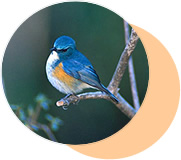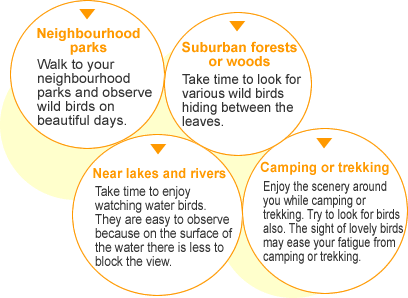 |
 |
 |
 |
Autumn
and winter are good seasons for beginners to start bird
watching.
As the leaves fall, leaving the treetops bare, anyone
with just a rudimentary knowledge of our feathered friends
will find it easier to spot wild birds. Observing ducks
or pigeons in the park is a simple form of bird watching. |
|
 |
 |
However,
when you want to move on to the next level and observe
a greater variety of birds with more precision and clarity,
then you need binoculars. Powerful binoculars open up
a whole new world of opportunity for those who want to
savour the graceful movements and behaviour of wild birds.
Binoculars offer a different perspective than that seen
with the naked eye and you will be able to enjoy bird
watching more than you ever thought possible. |
|
|
| |
 |
 |
 |
When you become an ardent bird watcher,
you develop sensitivity to seasonal and environmental changes.
You learn that certain birds appear in certain seasons and that
others are found all year round but behave differently in different
seasons. |
 |
| • |
You can enjoy
bird watching the minute you decide to start, before you even know
the names of the birds you are watching. Birds, like human beings
are warm-blooded vertebrate animals; so they have many movements
and actions in common with human beings. Try to imagine and understand
the behaviour of wild birds and you will feel closer to them! |
| • |
Try to find birds in the parks
or open spaces in your neighbourhood. |
| • |
First, observe them without
binoculars. |
| • |
If you find it interesting,
why not try observing them with binoculars? |
 |
| • |
Join a bird watching club
or society. You can learn how to locate wild-birds, how to use
binoculars for observing wild birds, and many other useful things.
An additional benefit of joining a club is the companionship you
will find there. |
| • |
Check out gardens with adequate
facilities for bird watching. You can experience bird watching,
even if you don't have binoculars or a Fieldscope to observe the
birds close up. |
|
| |
 |
 |
Binoculars make distant wild
birds appear closer. Therefore you can enjoy their colours and
the contours of their bodies much more clearly, which will make
you really appreciate the beautiful colours and fluffy softness
of the feathers. Because of their precision and power, Nikon's
binoculars make bird watching even more enjoyable. |
|
| |
 • Best
binoculars for bird watching • Best
binoculars for bird watching |
•
 |
Suitable
magnifications: |
 |
8x-10x:
for bird watching in woods and forests
8x-12x: for bird watching around lakes and in tidal wetlands
 |
|
| • |
Objective lenses
with large effective diameter: |
 |
When using objective
lenses with a diameter of more than 50mm, use a tripod
to avoid image vibration caused by binocular shake. |
|
| • |
Wide field of
view types: |
 |
With a wider field
of view, it is easier to follow the movements of wild birds. |
|
| • |
Lenses with high
performance: |
 |
Choose binoculars with
less distortion to the periphery of the field of view so
that they provide sharp images to allow you to observe
comfortably. |
|
| • |
Binoculars that
fit comfortably in your hand provide a sense of stability: |
 |
Actually pick up the
binoculars and look through them. Find the model best suited
to what you want. |
|
| • |
Waterproof or
water-resistance: |
 |
Waterproof or water-resistant
binoculars are recommended so there is no need to worry
about your binoculars when there is sudden rainfall or
when you use them in morning dew. |
|
|
|
| |
| • Binoculars are useful in
such scenes: |
 |
 |
| |
| • Recommended binoculars |
| |
|
| |
 |
|
 |
|
| |
|
|
Color of photographs
appearing in this www site may differ from the originals.
Specifications and equipment are subject to change
without any notice or obligation on the part of the manufacturer. |
| Terms of Use |
Privacy |
© 2009
Nikon Vision Co., Ltd. |
|





